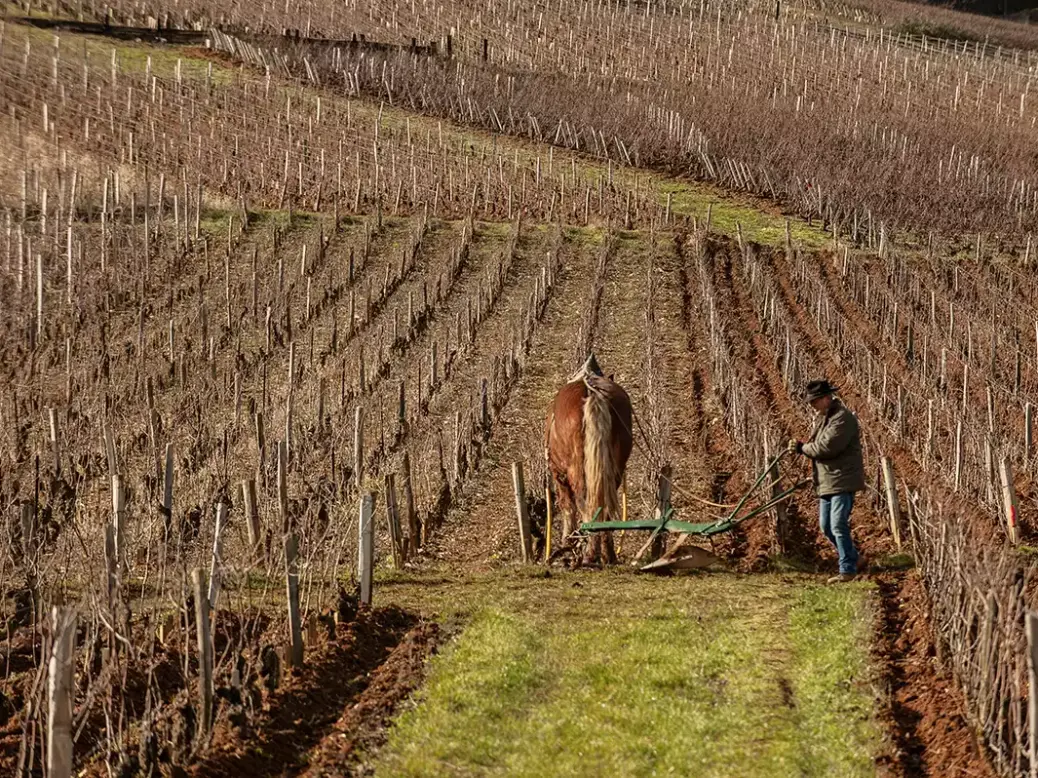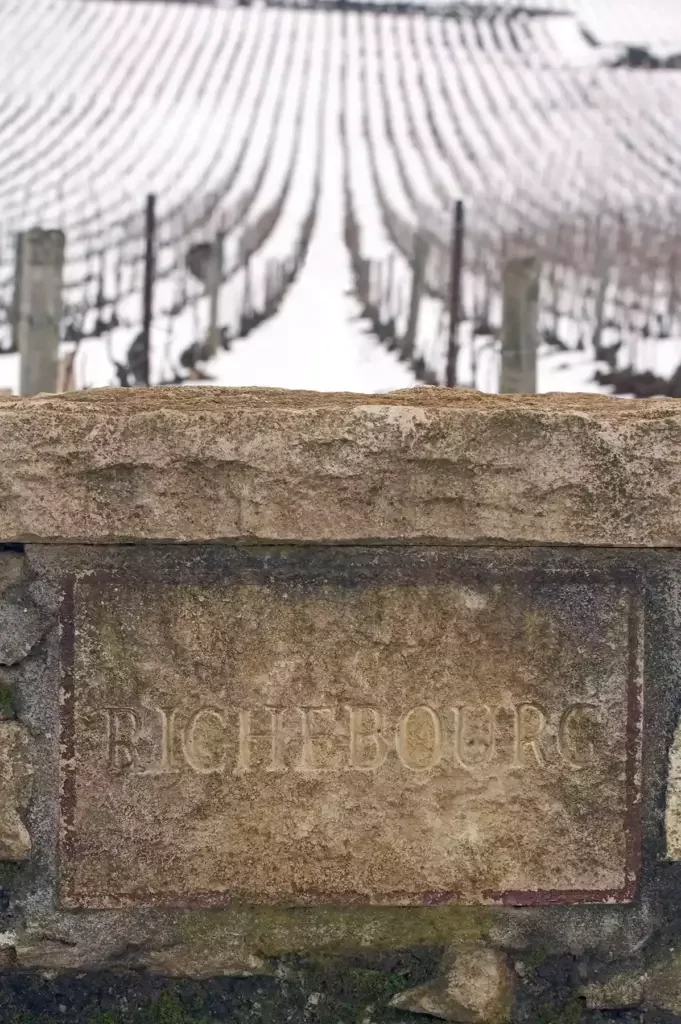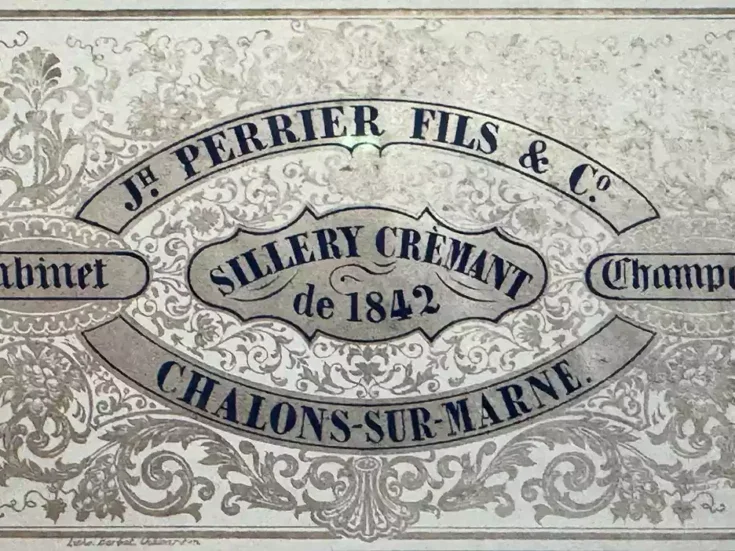
Low in production and discreet in proportion, Domaine de la Romanée-Conti’s latest releases are classic, fine, and very beautiful, says Michael Schuster.
Paucity—of quantity, of course, not of quality. For although this is clearly a lighter vintage, it is, for all its cool restraint and more modest proportions, a lovely one, which will make for especially beautiful mature bottles.
Production figures
As a consequence, above all, of the great overnight frosts of April 6–8, the 2021 vintage had one of the lowest yields of the past 50 years. The global yield, as in 2008, was a half-harvest, with particular extremes in the Côte de Beaune, where the red Corton and white Corton-Charlemagne gave a mere 5hl/ha, Le Montrachet just 7hl/ha. A loss of 80 percent in Corton and 90 percent in Corton-Charlemagne and Le Montrachet. You can see the details, and the context, at the head of each wine note.
The Domaine has comparatively low yields anyway, but like all Burgundy properties, its annual yields have been hugely variable over the past couple of decades, related largely to the weather extremes consequent upon climate change. From 2008 on, generous were 2017, 2014, and 2009; a healthy average were 2020, 2018, 2016 (with the exception of the severely frosted Échézeaux and Grands Échézeaux); variously paltry and meager were 2019, 2015, 2012, 2010; pitiable, in both cases, were 2021 and 2008, each producing a bare half-crop. (I didn’t taste and don’t have the figures for 2013.) At least 2022 and 2023 are looking generous.
The similarity in overall yield combined with their cooler growing seasons make 2021 and 2008 an instructive comparison in terms of style, quality, and aging prospects. And I happened to share a bottle of 2008 DRC with friends just a week before this Corney & Barrow tasting. It was illuminating, as I recount.
The growing season
The 2020/21 winter was mild, and after a cold February, budbreak began at the end of March, so the vines were exceptionally vulnerable to the severe frosts of April 6, 7, and 8, aggravated by the wetting effect of heavy snow on the 7th. The losses were dramatic and exacerbated subsequently, across the growing season, by disease: mildew, oidium, botrytis. After an overall cool April and May, a short burst of heat in mid-June at least allowed for a rapid, successful flowering. July and the first half of August were both cooler and wetter than usual; only late August and, increasingly, September saw the warmth that allowed the tiny harvest to ripen satisfactorily, its very skimpiness, as in 2008, being an advantage toward complete ripening at the end of this cooler year. Even then, the growing season’s unevenness and incidence of disease called for a severe trie of the harvested fruit—a further reason for its pitiful quantity.
Vintage style and quality
The year’s proportions are moderate, but the fruit was fully ripe—without the richer, super-ripe characteristics of most years since 2015. The wines remind me of the less fulsome vintages of the ’70s, ’80s, and ’90s. The grapes were thin-skinned, with a high proportion of liquid to solids, making for wines that are relatively pale in color. The flavor profile is of ripe red fruit, rather than black; the youthful aromas are “cool” to smell, alongside the herbal characters of 100 percent whole-bunch fermentation, and the wines are toothsomely carried and defined by fresh to lively acidities. What they lack in power and opulence, they make up for with finesse, delicacy, subtlety, and a deliciously lip-smacking vitality and core sweetness. The thin skins and very restrained extraction mean their tannin profile is discreet, superfine, almost imperceptible. But if their proportions are modest, and their relish is that of a quieter delivery, they lack for nothing in intensity of scent-as-savor. And a gorgeous fruit-fragrant persistence in the throat seems to be a feature of the year’s style. Many characteristics also of 2008—classic, fine, very beautiful DRC, that is.
Drinking dates
I mentioned last year that Corney & Barrow, the UK’s DRC agents, always recommend earlier drinking dates than I do (based on considerable experience, they are at pains to point out).
And it’s true, the wines are so beautifully made, especially these days, that they will indeed reward an early broaching. But if you can afford to wait those few more years, I would suggest that the rewards will increase exponentially, in terms of bouquet especially—and those when fully developed are so myriad, subtle, and seductive—but also in terms of overall ease and harmony. The 2008 Grands Échézeaux I describe below is a perfect case in point. Absolutely glorious at 16 years old, in a way it would not quite have been at ten or 12. A reminder that one of the defining aspects of fine wine is the ability to age and improve with grace and dividend. Gratification delayed, gratification at least doubled? My “accessible” drinking dates do not mean my ideal ones. If you can afford to wait…
Tasting 2021 Domaine de la Romanée-Conti
Corney & Barrow, London; February 7, 2024
Domaine de la Romanée-Conti 2021 Vosne-Romanée Premier Cru Cuvée Duvault-Blochet (149 dozen; 13.5% ABV)
A pale-rimmed mid-red. To smell, this is light, faintly peppery, a “cooler” vintage and whole-bunch herbal combination, with a raw red-cherry fruit, a sort of cool richness, but lovely and notably persistent in the glass. Medium-full, fresh to vital in acidity, very light in fine tannin; long, pure, transparent, graceful, a very nice tenacity of flavor in the year’s more delicate, restrained, less absolutely ripe vein, and with a faintly spicy, long, and palate-coating persistence. A cool, reserved, slightly edgy style, but this is very good. Currently, this has a more immediate fruit presence than the Corton. Sadly, there is practically nothing of it. Drinkable early, but no hurry. 2028–38+. | 92
Domaine de la Romanée-Conti 2021 Corton Grand Cru (5hl/ha [25hl/ha in 2020]; 105 dozen [454 in 2020]; average 2010–17: 413; highest since 2009: 707 in 2009; 13% ABV)
Pale-rimmed mid-red. Light, cool, herbal, and faintly smoky nose, fragrant. Lighter than the Duvault-Blochet; medium-full, gently fleshy, super subtle in tannin, brisk in acidity. A modest but tenacious fruit core, plus a gentle juiciness behind the slight youthful austerity, more crisply defined than the Premier Cru Cuvée, but here, too, a lovely, scented persistence on the finish. Class, finesse, breed, all in a slightly attenuated way. Likely to age with great charm and be accessible really very early—what little there is. 2029–40+. | 93
Domaine de la Romanée-Conti 2021 Échézeaux (14hl/ha [28hl/ha in 2020]; 636 dozen [1,280 in 2020]; average 2010–17: 1,195; highest since 2009: 1,549 in 2009; 13.5% ABV)
Pale-rimmed mid-red. The same “cool,” red-fruit, herbal character on the nose as on the Premier Cru Cuvée and the Corton, but with a touch more fruit core and density. A moderately rich, medium-full wine, fresh and very finely tannic. As you sense on the nose, there is both more flesh core and more sweetness of fruit on the palate, almost a succulence in this cooler vintage context. Sweetly red-fruit ripe, gently sappy, long, racy, and attention-holding, with a fine length of flavor and finish. A lightweight, beautiful ballerina. This will make a lovely, cooler, classic-year mature bottle. A touch more to this than the Corton. Here, too, accessible soon, but a long-term subtle pleasure as well. 2030–40+. | 93+
Domaine de la Romanée-Conti 2021 Grands Échézeaux (21.5hl/ha [33.5hl/ha in 2020]; 742 dozen [960 in 2020]; average 2010–17: 991; highest since 2009: 1,290 in 2017; 13.5% ABV)
Pale-rimmed mid-red, with a gentler expression of the cool/peppery/herbal theme, more quiet-voiced. Medium-full, fresh, very fine in tannin; an immediate sweetness to taste here, an unexpected, surprising core fruit, delicate but clear, a sort of gear change in concentration and matter, plus a touch of black-fruit ripeness, too. Long and succulent, not exactly rich but clear-cut and distinctive, a clinging mezzoforte clarity, a gently enveloping character, and the sweet, cool fragrance of the year, with gorgeous, throat-mantling, fruit-fragrant length. A particularly lovely, delicate, discreet Grands Échézeaux. 2031–41+. | 94

…………………………………………………………………………………
I have an interesting and—I like to think—illuminating comparison to make here, courtesy of trombonist (longtime section leader of the London Symphony Orchestra, then the Royal Opera House), composer, and conductor Eric Crees, and as a wonderful coincidence, given the immediately subsequent tasting of the 2021s. Five wine friends got together at the end of January, barely a week before the Corney & Barrow tasting, for lunch at Lorne restaurant in Pimlico, London, each of us bringing a special bottle. Eric’s was the 2008 DRC Grands Échézeaux, initially served blind, but unmistakable from the first whiff. Drinking this 2008 just a few days prior was pure serendipity, and tasting the 2021s at Corney’s made me think immediately of Eric’s bottle and of 2008 in general, in terms of both overall style and, as it happens, miserly yields. The 2008s were, perhaps, a mite sweeter-cored, but the similarity is striking. Here are my initial February 2011 and then my recent January 2024 notes.
Domaine de la Romanée-Conti 2008 Grands Échézeaux Corney & Barrow, London; February 8, 2011
Pale ruby-red. Finely scented, very gently herbal nose, glass-filling and persistent, with a touch of cooler year pepper. Beautifully balanced, supple, filmy middleweight, with an already silky textured tannin; a seductive combination of sweetness and vitality, a long, gentle, graceful, and effortless wine; delicate and understated, and yet with plenty of searching tenacity of flavor and lightly mouth-filling scent. Clear low-yield ripeness and concentration, and fine, sweetly fragrant length. Noticeably tighter than the Echézeaux, so it will need a bit more time. 2020–30+. | 93
Domaine de la Romanée-Conti 2008 Grands Échézeaux Lornerestaurant, London; January 30, 2024
Mature ruby. A fully developed bouquet of ripe cherry, leather, undergrowth, a touch of the farmyard, and a gentle herbal character, wonderfully alluring, complex, and persistent. Sweet, fresh, supple-textured, gently juicy, long and fine and fragrant. So good. Vital, racy, hugely persistent, sweet, pure transparent. Quite wonderful at 16 years of age, but no hurry either. 2024–34+. | 94
………………………………………………………………………………..
And I would imagine the 2021 aging trajectory is likely to be similar. The point to make is that a “lighter” style doesn’t have to mean a less moving performance. It is often, qualitatively, a very comparable pleasure, simply at a quieter dynamic—Mozart rather than, say, Schumann; chamber rather than orchestral, touching you just as much but with less force. A caress, not a clinch. And there is nothing mean in my 2021 scores (the ever-hateful duty): They just denote, where they are similar, something different from the figures for, for example, 2020 and 2019. The limitations, the paucity, the inadequacy of numbers…
Domaine de la Romanée-Conti 2021 Romanée-St-Vivant Grand Cru (14.5hl/ha [32hl/ha in 2020]; 755 dozen [1,718 in 2020]; average 2010–17: 1,250; highest since 2009: 1,756 in 2014; 13.5% ABV)
Notably darker in the lineup. Dense but tight, the cool/herbal character to the fore, but very persistent in the glass. To taste, this is rich in the vintage context: fairly concentrated, fresh, finely tannic; a wine in the lineup with more “matter,” more fruit freight. Long, distinctly vital, juicy, subtly ripe black fruit in flavor, already generous, embracing, and friendly, with a distinct succulence and a touch of come-hither warmth in this mainly “cool” character year. Long and fruit-cored across the palate, spicily aromatic to finish. This stands out stylistically, with a noticeable structure and vitality for 2021. Ideally it needs a little longer to yield, to mellow. 2033–43+. | 94
Domaine de la Romanée-Conti 2021 Richebourg Grand Cru (11.5hl/ha [32hl/ha in 2020]; 355 dozen [992 in 2020]; average 2010–17: 848; highest since 2009: 1,311 in 2009; 13.5% ABV)
Deepish, pale-rimmed mid-red. Quite rich to smell, with a softly herbal impression. Moderately concentrated, a gentle, but noticeable slight extra firmness of structure here, a fresh to vivid acidity and a fine, firm tannin definition. Very nicely constituted, with a lovely fruit core, freshly sweet, almost juicy, its 2021 coolness particularly well cloaked, an impression not so much of size as a gently firm completeness, and with an attention-catching, spicy persistence. A stylish, crisply creased posture, a little stiffly at attention as yet, but at ease, in due course, this will be an exceptional Richebourg, its discreet power and complexity more handsomely presented, more tautly defined than hitherto. For me, a star, at this stage, in the vintage. 2033–45+. | 95
Domaine de la Romanée-Conti 2021 La Tâche Grand Cru (8.5hl/ha [30hl/ha in 2020]; 579 dozen [1,237 in 2020]; average 2010–17: 1,386; highest since 2009: 2,082 in 2017; 13.5% ABV)
Deepish pale-rimmed red, with a nose of a different character, richer, denser. Cool, yes, but lingering, glass-filling, fruit-core suggestive. A rich medium-weight, freshly defined, very fine in tannin, with a notable breadth for 2021; cool, elegant, poised, and adding to La Tâche’s great class, a clear, supplemental fruit sweep for the year. Complex, vital, racy; not perhaps the seductively fleshy amplitude and immediacy it often has, but the scope is there: finesse, poise, class, ripe red-fruit vitality, a marked aromatic expanse, and great length. Full of medium- to long-term promise. 2032–45. | 95+
Domaine de la Romanée-Conti 2021 Romanée-Conti Grand Cru (20hl/ha [29hl/ha in 2020]; 403 dozen[500 in 2020]; average 2010–17: 432; highest since 2009: 657 in 2014; 13% ABV)
As so often, the palest wine in the lineup; and as always, glass-fillingly yet wonderfully subtle and delicate to smell, with the year’s cool, herbal complex, and the characteristic abundance in the glass. Fresh, very finely tannic, a beautifully reserved, restrained constitution, all poise and grace and transparency, so fragrant, so long, so delicate, and with, as in the 2008s, a distinct sweetness to the fruit. Enveloping in scent-as-taste, exciting in its quiet raciness, and supremely persistent. An extraordinary combination of extravagance and quietly disposed, serene inner energy—musically, the equivalent of an emphasis on absolute quality of sound as distinct from its volume. The almost weightless, infinite subtlety and sweetness that is the similarly constituted 1980 Romanée-Conti today, at 40 years and more, is testimony to just how seductively this will likely age, too. 2035–60+. | 97
Domaine de la Romanée-Conti 2021 Corton-Charlemagne Grand Cru (5hl/ha [49hl/ha in 2020]; 165 dozen [1,530 in 2020]; 14% ABV)
Pale gold. A refined, notably persistent, peach and tangerine fruit to smell; a seductive nose. This is a moderately concentrated wine for the appellation, fresh and well defined, if without Corton-Charlemagne’s more classic cut, sinew. Rich and gentle, with an easy, equable constitution for the cru—though as you taste, you notice the defining acidity more than on the initial impression. Taut and fine, complex and racy and complete; long across the palate, long and gently resonant to finish. But this 2021 is without the drama and presence, the showstopping grandeur of either of the previous two, initial DRC vintages. A restrained, graceful (not a vocabulary one normally associates with this climat) Corton-Charlemagne, at a mezzopiano dynamic, in keeping with the reds of the year—but with its grand cru class, length, and completeness all thoroughly intact. A lovely wine. Beautiful, biddable, and gracious rather than grand. As if that matters… 2027–37+. | 94+






